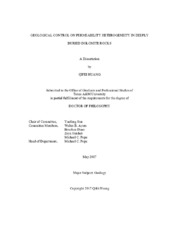| dc.description.abstract | Geological deposition and diagenesis in carbonate rocks are strongly affected by sea level fluctuation, which can result in significant heterogeneity in pore types, elastic properties, and permeability. In this dissertation research, the mechanism of dolomitization of deeply buried carbonate reservoirs in Sichuan Basin, China is investigated in comparison with shallow carbonate microbialite in Alabama, USA. Based on rock physics, geological factors controlling elastic properties and permeability heterogeneity of carbonate rocks are further studied quantitatively, integrating core, well log and seismic data.
Core and log measurements were first integrated to estimate pore type variation within the Feixianguan carbonate reservoirs in Sichuan Basin, China. The results show that cementation factor (m) from Archie’s equation and frame flexibility factor (γμ) from a rock physics model are the most effective pore structure indicators for distinguishing diagenetic pore types of the recrystallized rocks, and thus, for classifying permeability-porosity relationships.
The variation of γμ is then applied to correlate pore type variations with sea level cyclicities of different orders. The results show that a general trend of γμ curve correlates with eustatic sea level cycle, while the two prominent changes of the curve differentiated the three relative sea level cycles by recognizing the episodic subaerial dissolution. Each cycle is characterized by the initial development of moldic porosity (γμ < 4) followed by intercrystalline porosity (γμ > 4) with decreasing pore size and increasing γμ. The pore type evolution corresponds to the process of seepage refluxing associated with sea level regression. Further integrated analysis of γμ variation, and δ^18 O and δ^13 C isotopes, cathodoluminescence images, confirms that reflux dolomitization played a key role in the studied Feixianguan Formation. Dolomitization started at shallow tidal flat or lagoon in the form of protodolomite by microbial dolomitization, which continued to grow following the seepage reflux of sea water. After the burial, the early dolomite was further recrystallized. Seismic inversion is also applied to estimate permeability, using the different permeability-porosity relations constrained by γμ from the core and log analysis. The results shows strong heterogeneity in the spatial distribution of permeability and can be used to guide field production. | en |


